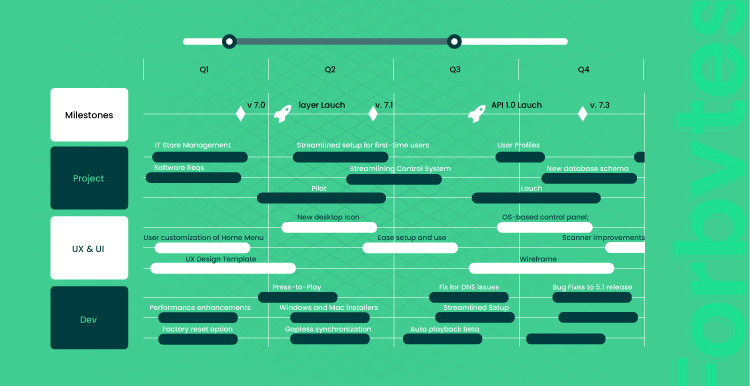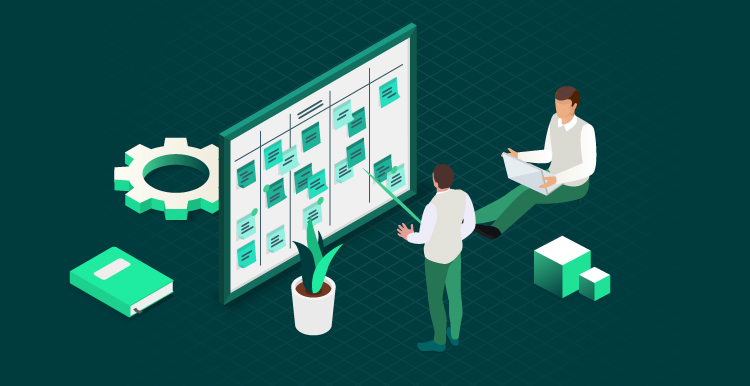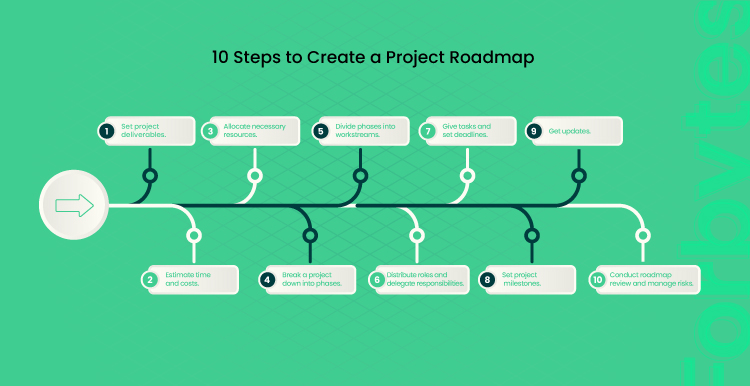Statistics show that nearly 90% of startups fail. More than 20% of them fail during the first year of operation, while 30% don’t manage to survive in the second year. Among the most common reasons why this happens are financial issues, timing problems, vague business plans, and lack of experts. We may surprise you if we say that most of these obstacles can be eliminated with an effective project roadmap. This is what today’s article is about.
What Is a Project Roadmap?
The newcomers may ask, “What is a road map and why do I need it if I already use project management software?” The name speaks for itself. A roadmap is an overview of key components and strategic steps of a project and the description of how, when, and who will complete these steps. A project roadmap serves as a guide for you and your project team to see at which point of the product development you are and how things are going.
Project roadmaps give businesses the chance to look at product development from a bird’s eye view. If you hire a project manager, a roadmap will allow you to control all operations and be aware of how your resources and time are used. If you are creating a roadmap by yourself, it will give you the chance to organize product creation in a clear and manageable way. Our additional tips for project managers are aimed to improve the time and resource management on individual projects. So, check them out.
Can I Succeed Without a Roadmap?
Some people may say, “Why do I need a project roadmap if I can create a plan and just follow it?” The thing is, a project plan instructs your team on what they should do at the given time. Unlike plans, roadmaps give everyone an understanding of the whole journey from start to finish.
The long-term effect of not having a roadmap manifests itself in many ways. A common symptom is that you have started using quick fixes to speed up the project — only to find that it is actually taking longer. This leads to poor quality work. Work is assigned to keep developers busy because they are just waiting for others to complete their tasks. Jobs are no longer done in order. As a result, a team has to re-do functionality that probably won’t match. It is time-consuming and leads to delays and increased costs. You also end up losing trust in each other. Both the developers and the end customer face endless frustration. Without a road map, you cannot develop a meaningful breakdown of work. Your project will waste people’s time and resources and cost more to deliver.
Benefits of Roadmap Project Management
Road map project management helps you control project scope, deadlines, and deliverables. By choosing this method, you can:
- Set the right priorities. In this project chapter, you need to set deliverables and rank them by importance. It will help you understand what product features to build first and what functions can wait for product updates.
- Make sure that project stakeholders trust you. Keep stakeholders informed about the project’s progress. It will increase their trust in your work. With a ready roadmap, you get more chances to raise funds, find a loyal audience, and earn team recognition.
- Communicate your expectations. Everyone in your team will be on the same page and will keep track of project changes. Your executives will get a comprehensive picture of product functions on the background of its overall value.
- Share your vision with others in a measurable way. A project management roadmap unifies the team’s view on their tasks. They see how their effort affects product growth and realize why their contribution matters.
- Add flexibility to your project. Project management roadmaps allow you to adjust the development process without turning it into a mess. You become more flexible. This makes your stakeholders feel safe about the resources and ensures effective performance throughout the project lifecycle.
Roadmap vs Timeline
Not to confuse road mapping with creating timelines, we need to understand the difference between these two notions. Let’s start with the project roadmap. This is a map of your product journey, with the sequence of activities that lead to the final goal. Meanwhile, the function of a timeline is to schedule your project activities. It’s more about timing and deadlines than routes and decisions.
You will need both a roadmap and a timeline for your project. A roadmap will give you a view of where to move to get closer to your goal. A timeline will enable you to set the time for each step and estimate the period needed for task completion. So, a roadmap will set the direction, while a timeline will arrange your way in the form of scheduled tasks.
Important Elements of Roadmapping
You already know why you need road mapping. Now, it’s time to gather all the data concerning your project. A project road map cannot exist without these elements:
Vision
Your project should start with building a long-term product vision. You should set clear expectations for your product and outline key problems that your product will solve.
Try to think about your project from the perspective of the target audience. What pains they can solve with your product? Make sure the product’s functions implement the solutions to these pains. Also, think about product potential on the market. Apart from being popular today, your project needs to be relevant tomorrow. We know a lot of stories of promising startups that were at their peak popularity for several months. But people forgot it as soon as their excitement passed. To avoid such a scenario, build a comprehensive vision of how your product might grow. Of course, this will not be a finalized plan. But at least you will get an understanding of whether your idea will survive on the market.
Strategy
Product vision adds practical value to your creative idea. But it’s also important to consider the business side of the question. This is why you should start building your product strategy. This element blends your product vision with the business reality in which your idea will operate.
To be brief, product strategy is a business case of your idea. A strategy has to implement your goals and meet stakeholder expectations. Product strategy is important not only for a product owner but also for all stakeholders. Those can be internal and external and include executives responsible for project growth. Product strategy has to help you manage stakeholder expectations and show them the benefits they will get when a project grows.
Requirements
One more important element of product roadmapping is requirements. To understand this aspect properly, involve the sales team in the discussion. Or talk to the employees who frequently communicate with your target audience. These could be the representatives of the support department or customer service department. With their help, outline what features your audience expect to see in your product and how do they feel about your suggestions.
This information will help you set clear priorities for the project. You will know what features you should build ASAP and what can wait for the budget extension.
Plan
A plan is another element of road mapping essential for successful project completion. A plan allows you to be clear about your actions. In fact, there is a difference between a strategy and a plan. A strategy gives you a set of principles to guide your decision-making. It shows you the direction under which you will move toward your goals and explains why you need to make a particular step. Meantime, a plan answers the question of who, when, and how will execute these steps. It serves as detailed instruction for the tasks assigned to your team. Planning allows businesses to see product development as a step-by-step process. With a plan, you put a task into a timeline and assemble a person responsible for its execution.
Markers
You and your team need to have clear markers of successful task execution. For you, markers will improve accountability and ensure more control over the project. For a team, they will boost responsibility, proactiveness and make tasks more manageable. Markers allow you to see whether your project is moving toward goals or gets stuck in one place. With this information at hand, you will be able to run a schedule overview to detect factors that make your project lag behind.
Metrics
Last but not least, a metric is one of the most important elements of product roadmapping. There’s a difference between metrics and markers. Markers point to the goal completion. These are your targets or goals which you aimed to achieve to move to a new level. Meantime, metrics cannot turn into goals. They just enable you to systemize measurement in a team. By setting metrics on a project, both you and your executives have the same understanding of measurement units used on a project.
10 Steps to Create a Project Roadmap
If you use some project management software, you can choose a project roadmap template there. But if you decide to create a roadmap from scratch, consider following these 10 steps. By doing this, you will be able to stick to the project schedule and go through all project milestones successfully:
1. Set project deliverables.
Your deliverables should be clear, measurable, and trackable. They should be based on your vision, reflect your strategy, and implement your plans. Goals cannot be general — you should describe them much in detail. Build project goals around the product value. Create a layout, make the list of features, functions, and key stakeholders, provide examples and references. This will be needed for dividing a project into steps and for expert/stakeholder review of road mapping.
2. Estimate project timeline and costs.
When creating a roadmap in project development, evaluate its approximate scope. You should outline how many people you will need, how much you will pay them, and how much time it will take them to complete your tasks. If you have a limited budget, your evaluation should start from costs to be distributed to different aspects of your project. In this case, base your estimation on project priorities, highlighting the essential features and roles.
3. Allocate necessary resources.
Now you know who and when should do a task and how much it will cost. That is, you can move to the search for project executives. Find a software engineering company and choose the best development strategy in your case. A good idea is to hire an Agile development team to boost your effectiveness and development pace.
4. Divide the work into project phases.
Not to miss anything and track project progress, you need to divide your project into phases. These are the set of activities vital for completing one of the project objectives. For instance, there may be the phase of prototyping, testing, developing specific features, etc.
5. Divide phases into workstreams.
Project roadmaps are divided into phases that consist of workstreams. The difference between a workstream and a phase lies in the fact that workstreams run simultaneously while phases run one after another. For example, there is a project phrase where you develop the function of a one-click financial report for a finance management app. This task will involve several workstreams executed by a UI/UX designer, content manager, developer, and QA. While a designer will develop a mockup of the function button and the report layout, a content manager will build its structure and content. Meanwhile, a developer will turn the vision into the code, with QA testing the function responsiveness and correctness.
6. Distribute roles and delegate responsibilities.
Choose individuals and distribute teams responsible for achieving project goals. For each workstream and phase, decide upon key roles and functions. It will help you make the project more controllable as you will share the ownership of control with other key players on a project. Not to get confused with the ownership question, use project management software. It will enable you to see who does a task and how much time it takes for them to complete it.
7. Give tasks and set deadlines.
You should have a clear understanding of your team’s skillset, knowledge, and abilities. To distribute tasks effectively, you need a little software development background. Without tech experience, you will not know for sure how much time on average is devoted to a particular task.
8. Set project milestones.
Milestones mark the end of a project phase. They help to evaluate what was good, what was bad, what can be improved, etc. In other words, milestones are the meetings where a team discusses progress, challenges, and achievements. This all is with the purpose: to make the execution of the next phases more effective and efficient.
9. Get updates.
Use recognized communication tools to get updates on project execution. By doing so, you will establish regular accountability in a team and maintain quality communication. Also, you will avoid project delays as you will keep track of the progress on a daily basis and introduce necessary measures as soon as the need arises.
10. Conduct roadmap review and manage risks.
In the course of the project execution, some changeable aspects may have an impact on your roadmap. It will require you to adjust project planning to new challenges or opportunities. This is why you should not be afraid of roadmap review and risk management. Both will enable you to stay flexible and ensure stable growth for your project. Having a project risk management plan will also minimize adverse impacts and losses.
What’s Next?
Creating a project roadmap is not as easy as one may think. Having a prospective idea is only the beginning of the way, especially when it comes to software development projects. You can use project roadmap tools to facilitate your effort. But for effective project completion, you need to have every aspect under control. You should track progress regularly and organize the internal processes so that you see how you are moving to the final target.
To plan each step effectively, you need to have a little software background. That is, to assign the right tasks to the right people, you need a bit of tech knowledge. If you lack it, it is better to entrust building a roadmap to expertized project managers. Experiences PMs will help you turn your idea into a workable project, with clear steps, goals, and endless business potential.

Our Engineers
Can Help
Are you ready to discover all benefits of running a business in the digital era?

Our Engineers
Can Help
Are you ready to discover all benefits of running a business in the digital era?











